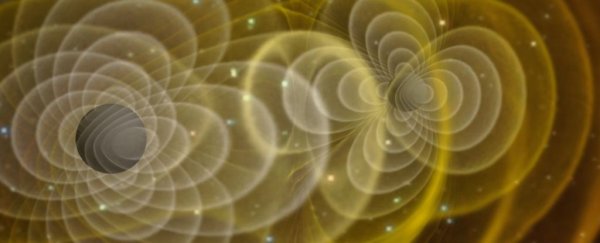Ever since scientists made the first detection of gravitational waves from a pair of colliding black holes in 2015, evidence has been growing that the Universe ought to be full of them.
Every massive event – every black hole or neutron star merger, every supernova – should have sent gravitational waves ringing out across space-time.
The combined effect of all these waves would be to create a faint, background hum that permeates the entire Universe. This gravitational wave background is predicted to be weak and very hard to detect. Nevertheless, a year ago, scientists with the international NanoGRAV collaboration said they may have done just that.
Now, from the International Pulsar Timing Array (IPTA) consortium, tentative new evidence that we may have detected the hum has emerged. If confirmed, this will be a very big deal indeed.
"This is a very exciting signal!" says astrophysicist Siyuan Chen of the Observatory of Paris and CNRS in France.
"Although we do not have definitive evidence yet, we may be beginning to detect a background of gravitational waves."
As we explained last year, the signal comes from observations of a type of dead star called a pulsar. These are neutron stars that are oriented in such a way that they flash beams of radio waves from their poles as they rotate at millisecond speeds comparable to a kitchen blender.
These flashes are incredibly precisely timed, which means that pulsars are possibly the most useful stars in the Universe.
Variations in their timing can be utilized for navigation, for probing the interstellar medium and studying gravity. Since the discovery of gravitational waves, astronomers have been using them to look for those, too.
That's because gravitational waves warp space-time as they ripple through, which theoretically should change – ever-so-slightly – the timing of the radio pulses given out by pulsars as space-time between us and them stretches and contracts.
A single pulsar wouldn't be able to tell us much, but if these timing variations are observed in a number of pulsars, that could indicate the presence of gravitational waves. This is called a pulsar timing array.
The team's dataset is based on observations of 65 millisecond pulsars, the timing of which displayed characteristics consistent with what we'd expect from a gravitational wave background.
It's not solid evidence, at least not yet. But it's a step closer to it.
What scientists really need to see is a particular signal in pairs of pulsars, the strength of which depends on their spatial distance in the sky. We haven't seen that yet, because the signal is too weak, but the signal we have seen is what we'd expect to see first.
"The first hint of a gravitational wave background would be a signal like that seen in the International Pulsar Timing Array Data Release 2," says astrophysicist Bhal Chandra Joshi of the National Centre for Radio Astrophysics in India.
"Then, with more data, the signal will become more significant and will show spatial correlations, at which point we will know it is a gravitational wave background. We are very much looking forward to contributing several years of new data to the IPTA for the first time, to help achieve a gravitational wave background detection."
Other causes of the signal also need to be ruled out.
"We are also looking into what else this signal could be," says astrophysicist Boris Goncharov of the Gran Sasso Science Institute in Italy.
"For example, perhaps it could result from noise that is present in individual pulsars' data that may have been improperly modeled in our analyses."
That means there's a lot more science to do before we can definitively claim that the gravitational wave background has been detected. But with the evidence to hand, it's reasonable to start getting a little bit excited.
That's because, if we have detected the gravitational wave background, the likeliest source is from collisions between some of the most massive objects in the Universe – supermassive black holes.
This means that the signal could help resolve such conundrums as the final parsec problem, which poses that supermassive black holes might not be able to merge, and help us better understand galactic evolution and growth.
"The detection of gravitational waves from a population of massive black hole binaries or from another cosmic source will give us unprecedented insights into how galaxies form and grow, or cosmological processes taking place in the infant Universe," says astrophysicist Alberto Vecchio of the University of Birmingham in the UK.
"A major international effort of the scale of IPTA is needed to reach this goal, and the next few years could bring us a golden age for these explorations of the Universe."
The team's research has been published in the Monthly Notices of the Royal Astronomical Society.
